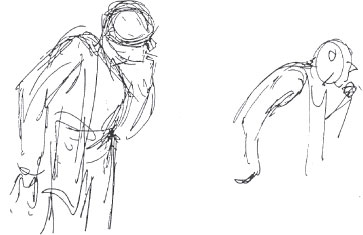Most of our daily activities could not be classified as spectacular. As a matter of fact most of our movements are rather confined. It’s usually with a bit of self-consciousness that we flail our arms or act out some part of our dialog. Yet nothing is lost in our communication with others because they are “tuned in” to us auditorily. That is, they are in a listening mode. Sometimes someone will gesticulate with his hands while talking, which often pulls our attention away from the verbal attachment.
Drawing and animation are, in contrast, not auditory but visual. Therefore visual clarity is necessary. Oddly enough, verbalizing a pose or a gesture mentally before starting to draw will help to disengage any obstacles that might stand in the way of drawing the idea clearly. For instance, if you have a character looking at someone or something, verbalizing it by saying to yourself: “This guy is looking at something (how much clearer can you be than that?), so I will get every obstacle out of the way… like pulling back (in this case) the right shoulder. Then to show he is interested in what he is looking at, I’ll have him lean forward. This can be done by bending him forward at the waist, and also by stretching his neck forward (still pretty simple and clear).” Voila! that gives me some squash and stretch, the salt and pepper of drawing and animation. And voila #2, I now have what Stanchfield calls the “first impression.”

Here is another example. Maybe same pose with different artist, but same dialog.

Run through some of our feature cartoons and notice how many scenes are just “looking” scenes. I would venture to guess 90% of them. (Not counting Sleeping Beauty and Rip Van Winkle) So it’s not like we are talking about an action that just comes along every 100 feet or so, so why spend so much energy on it? Cartoons are not only mainly visual but the characters in them are visual – they look and see. Here’s another example. This guy is not only looking at something, he is wondering about it also. What better way to show this than to have him bend forward. Note I simplified the bend by exposing his bent back. This allowed me to more clearly show the neck projecting forward from the back and upper chest. Then since he is bent forward, his garments in front can just hang down. That makes a nice use of straight (chest) against curve (back). And what better way to display bewilderment than to have a “sag” (the garments in front) somewhere in the drawing. The line of the bent back also helps to project the eye direction. The straight of the chest acts as a soundboard (sight board) for the look, like a ball bouncing off a handball court. All this came about through verbalizing what I wanted to make visual. It has nothing to do with highfalutin theory or complicated postulations. It is an act of simplification, a means of clarifying the “story” in my mind and how best to portray it (see the following illustration).

Here is another pose that would be difficult to capture without some personal verbal guidance. The model had her left elbow stretched up a little higher than the right. “Stretched” was the clue word (verbal clue). So I turned that whole side into a stretch, using ziggy-zaggy lines on the other side for the squash. It may seem like an oversimplification of the problem, but if it’s not clear in your mind, chances are it’s not going to be clear in your drawing. The thing is it has to be clear in both places, for you can verbalize in your mind before making the drawing, but after the drawing is made you can’t follow it around verbalizing an explanation to everyone who looks at it. Here are two artists’ attempts at this pose plus my (possible) clarification.

Awaken the storytelling capabilities in your mind and use whatever means you can to funnel it into your drawing. At this point I just don’t know of another way than to rehearse it in your mind (verbalize) so you know what it is you are attempting to say like an actor who rehearses his lines and stage directions. If you can verbalize it, at least that means you are not sketching ghosts — you’ve something very tangible to work with.
I sometimes speak of logic in drawing. Here’s a case in point. Stand up and try to bend from the waist to your right. Does your left hip want to protrude? It sure does. As a matter of fact it’s almost painful to try to bend without that hip shooting out. If that knowledge isn’t second nature to you yet, and if it’s not real obvious on the model, then you’re just going to have to have a friendly chat with yourself. Don’t be embarrassed for having to instruct yourself on such simple matters, you’ll be happy for it when you see the results. After all it’s not pride your working for – it’s results. Make the verbal advice clear and simple, say, “Hey, look man, when someone stands with their weight on the left leg — the left hip naturally protrudes. The whole hip tilts as a result, especially when the right knee is bent. It looks almost like the right knee is pulling the right side of the hip down. It adds movement and tension to the drawing.” You sketch that. “Wow,” you will probably say, “that’s great,” and will be encouraged to continue in that vein, “now, since the hips are tilted that way the shoulders would most likely tilt the other way for balance…,” etc. Remember, clarity doesn’t just happen — it’s created.

